Conde, Jones Had Hand in Hire That Created Uproar
AP: Police Caused More Than 1,000 Needless Deaths
Martin Blasts Black Outlets for Rewriting Others
Marvin Lake, Pioneer at Virginian-Pilot, Dies at 80
Detroit Palestinian TV Journalist Claims Bias, Sues
Award for Hostage-Taking Photo Praised, Slammed
Did Haitian Prosecutor Order Journalist’s Killing?
Attacks on DEI Enter Coverage of Bridge Collapse
Short Takes: settlement for reporters who covered George Floyd protests; column changed after criticism as sexist, racist; Andrew Simon; media bias against scientists with East Asian, African names; changes in race and ethnicity on federal forms; symposium, bust unveiling for Ida B. Wells; should NABJ challenge “deep fakes?”; Dow Jones Columbia J-School’s HBCU initiative;
“Lost cause” myth in northern newspapers, among today’s politicians; Joy Sewing; Cynthia Benjamin; “Helping Prisoners to Heal”; robbery of independent Cuban journalist; settlement in Britain over Black Lives Matter protest coverage; press freedom in East Africa.
From 2007: Marvin Lake, first black summer intern at The Pilot, caps a 40-year career in journalism
Support Journal-ismsDonations are tax-deductible.
Host Kristen Welker questioned Ronna McDaniel last week on NBC’s “Meet the Press” (Credit: YouTube)
Conde, Jones Had Hand in Hire That Created Uproar
The NBC fiasco over the rapid hiring and dismissal of Ronna McDaniel, the former chair of the Republican National Committee, put a harsh glare on two of the highest-ranking people of color in television news: Cesar Conde and Rashida Jones.
The hiring of McDaniel led to an open revolt by NBC and MSNBC stars, who cited McDaniel’s involvement in former president Donald J. Trump’s efforts to overturn the 2020 election results.
 “For Conde (pictured), who is believed to be angling to rise to the CEO job at NBCUniversal in the fullness of time, it’s fair to question whether this deeply embarrassing episode will have major consequences,” Kim Masters reported Wednesday for The Hollywood Reporter. “Looking at the bigger picture, the fiasco raises questions about decision-making, not only in the news division, but at NBCU overall.”
“For Conde (pictured), who is believed to be angling to rise to the CEO job at NBCUniversal in the fullness of time, it’s fair to question whether this deeply embarrassing episode will have major consequences,” Kim Masters reported Wednesday for The Hollywood Reporter. “Looking at the bigger picture, the fiasco raises questions about decision-making, not only in the news division, but at NBCU overall.”
“Conde didn’t exactly fall on his sword by himself; he mentioned in his letter to staff that this was ‘a collective recommendation by some members of our leadership team.’ But he acknowledged that the buck stopped with him,” Masters wrote.
In 2020, Conde became the first Hispanic leader of any major English-language TV news organization. He is chairman of the NBCUniversal News Group, the largest news organization in the country, encompassing NBC News, CNBC, MSNBC, NBC News NOW, Telemundo Enterprises and NBCUniversal Local. His father, Cesar A. Conde, is a cardiologist and an immigrant from Peru, and his mother, Maria Conde, is an immigrant from Cuba.
When Jones was named president of MSNBC in December 2020, she became the first Black journalist to head a mainstream network or a news division.
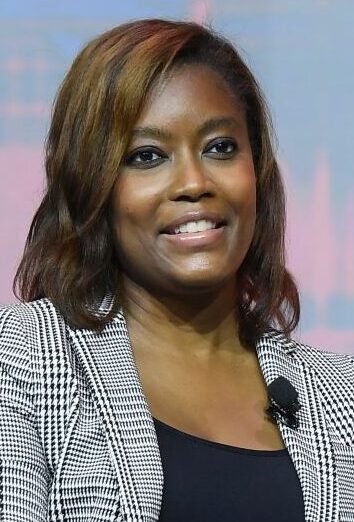 On Wednesday, Sarah Ellison and Josh Dawsey reported for The Washington Post that Jones (pictured) participated in recruiting McDaniel “and McDaniel was offered a more lucrative contributor contract after she agreed to appear on MSNBC and not just NBC News, according to people familiar with the matter.”
On Wednesday, Sarah Ellison and Josh Dawsey reported for The Washington Post that Jones (pictured) participated in recruiting McDaniel “and McDaniel was offered a more lucrative contributor contract after she agreed to appear on MSNBC and not just NBC News, according to people familiar with the matter.”
“NBC News said on Tuesday that McDaniel — who repeatedly backed Donald Trump in raising questions about the validity of the 2020 election and helped organize a scheme involving alternate electors — would not appear on the network as a paid contributor after MSNBC’s anchors repeatedly attacked the hiring and called for the decision to be reversed.
“But Jones had a one-on-one video call in early March after an executive at NBC News orchestrated the contact, according to the people familiar with the matter, who spoke on the condition of anonymity to discuss sensitive internal discussions.
“McDaniel was concerned she would face particularly harsh interviews, and the liberal-leaning viewers would not respond to her positively, according to people with knowledge of her concerns. Her original preference was just to appear on NBC News, the people said, and early talks with the network had centered around NBC appearances.
“In a friendly call between Jones and McDaniel, the two spoke about American politics, their young children and the need to have differing views on the airwaves, the people familiar with the matter said.”
NBC did not respond Saturday to a question from Journal-isms about the accuracy of the Post story.
But other reporters drew similar conclusions.
“To many at NBCU, it seems inexplicable that these executives failed to anticipate the outrage that ensued. But some insiders maintain that no one in the news division raised any objection to the deal before it was announced — not even MSNBC chief Rashida Jones, who subsequently reassured the rebelling hosts that McDaniel would not appear on the network’s air,” Kim Masters reported Wednesday for the Hollywood Reporter.
Oliver Darcy wrote for CNN, “Over at MSNBC, Rashida Jones, the network chief, did not escape unscathed.“ Dylan Byers of Puck “reported that not only did Jones initially not object to McDaniel’s hiring, but that she expressed interest in having the election denier on the progressive cable network.”
- Rachael Bade, Politico: McDaniel eyes big payout after NBC drama (March 27)
- Michael M. Grynbaum and John Koblin, New York Times: In Saga of NBC and Ronna McDaniel, Perks and Perils of Partisan Talk on TV (March 27)
- Cameron Joseph, Columbia Journalism Review: The Ronna McDaniel incident reveals a deeper dilemma for journalism (March 29)
- Michael Luciano, Mediaite: Fox’s Laura Ingraham Scoffs at Notion Trump Demands Loyalty After Her Network Slavishy Repeated His Election Lies to the Tune of $787.5 Million (March 27)
- Kim Masters, Hollywood Reporter: The Leadership Vacuum That Led to the Ronna McDaniel Fail at NBC
- John McCormick, Wall Street Journal: Ronna McDaniel’s NBC Dismissal Shows How Election Denial Weighs on GOP, Media (March 27)
- Eugene Robinson, Washington Post: The RNC’s Ronna McDaniel is not ready for her NBC close-up (March 25)
- Brian Steinberg, Variety: NBC News Faces Growing Pressure as Its Journalists Rebel Against Ronna McDaniel (March 25)
- Brian Stelter, Fast Company: NBC News’ Ronna McDaniel blowup was inevitable (March 27)
- Margaret Sullivan, the Guardian: Can NBC News recover from its damaging decision to hire Ronna McDaniel? (March 26)
- Alex Weprin and Kim Masters, Hollywood Reporter: NBC News Ousts Ronna McDaniel After Staff Uproar, CAA Drops Ex-RNC Chair (March 26)
AP: Police Caused More Than 1,000 Needless Deaths
“Carl Grant, a Vietnam veteran with dementia, wandered out of a hospital room to charge a cellphone he imagined he had. When he wouldn’t sit still, the police officer escorting Grant body-slammed him, ricocheting the patient’s head off the floor,” Reese Dunklin, Ryan J. Foley, Jeff Martin, Jennifer McDermott, Holbrook Mohr and John Seewer reported Thursday for the Associated Press.
“Taylor Ware, a former Marine and aspiring college student, walked the grassy grounds of an interstate rest stop trying to shake the voices in his head. After Ware ran from an officer, he was attacked by a police dog, jolted by a stun gun, pinned on the ground and injected with a sedative.
“And Donald Ivy Jr., a former three-sport athlete, left an ATM alone one night when officers sized him up as suspicious and tried to detain him. Ivy took off, and police tackled and shocked him with a stun gun, belted him with batons and held him facedown.
“Each man was unarmed. Each was not a threat to public safety. And despite that, each died after police used a kind of force that is not supposed to be deadly — and can be much easier to hide than the blast of an officer’s gun.
“Every day, police rely on common tactics that, unlike guns, are meant to stop people without killing them, such as physical holds, Tasers and body blows. But when misused, these tactics can still end in death — as happened with George Floyd in 2020, sparking a national reckoning over policing. And while that encounter was caught on video, capturing Floyd’s last words of ‘I can’t breathe,’ many others throughout the United States have escaped notice.
“Over a decade, more than 1,000 people died after police subdued them through means not intended to be lethal, an investigation led by The Associated Press found. In hundreds of cases, officers weren’t taught or didn’t follow best safety practices for physical force and weapons, creating a recipe for death. . . .
“The toll, however, disproportionately fell on Black Americans like Grant and Ivy. Black people made up a third of those who died despite representing only 12% of the U.S. population. Others feeling the brunt were impaired by a medical, mental health or drug emergency, a group particularly susceptible to force even when lightly applied. . . .
“AP’s three-year investigation was done in collaboration with the Howard Center for Investigative Journalism programs at the University of Maryland and Arizona State University, and FRONTLINE (PBS). The AP and its partners focused on local police, sheriff’s deputies and other officers patrolling the streets or responding to dispatch calls. Reporters filed nearly 7,000 requests for government documents and body-camera footage, receiving more than 700 autopsy reports or death certificates, and uncovering video in at least four dozen cases that has never been published or widely distributed. . . .”
“if any reporter or intern sent this story to me my response would be, ‘your ass got one shot to fix it or you’re fired.’ “
Martin Blasts Black Outlets for Rewriting Others
Roland Martin blasted the practice by some Black online news outlets of rewriting others’ work and publishing it without attempting to verify the information, singling out a Black Enterprise story on Sean Combs last week reported by TMZ.
Martin said the story, which said that Combs “is no longer an owner at Revolt TV after selling off his shares to an anonymous buyer for an undisclosed amount,” was “flat-out wrong.”
“Nowhere in in this article did it say Black Enterprise reached out to Revolt to confirm or deny the story,” Martin said Thursday on his online “Roland Martin Unfiltered.” “Nowhere in an article did it say, ‘Black Enterprise reached out to Sean “Diddy” Combs, nowhere.
“We just slap our name on a story and rewrite what TMZ said. You put in a story speculation. No, y’all, I was the managing editor of the Dallas Weekly, the Houston Defender, the Chicago Defender; the news editor at Savoy Magazine, was the top editor at BlackAmericaweb.com. And let me be real clear, if any reporter or intern sent this story to me my response would be, ‘your ass got one shot to fix it or you’re fired.’ “
Martin said Wednesday that he has “spoken with multiple sources who informed him that the deal has not been finalized (video), adding that there is more work to be done on this particular deal.”
Alfred A. Edmond, Black Enterprise senior vice president and executive editor at large, and Derek T. Dingle, executive vice president and chief content officer, did not respond to a request for comment.
Tashara Jones, citing unidentified sources, reported for the New York Post’s Page Six Thursday that “Richelieu Dennis will be the new owner of Diddy’s TV venture, Revolt, Page Six is told.“
Dennis is a Liberian-born entrepreneur who led Essence Ventures, which was created to buy Essence magazine in 2018.
Essence and other websites, Black and white, also picked up the TMZ story, but the Essence account has apparently been removed.
Martin said Black outlets’ simply rewriting stories from white-owned sources gives the stories unwarranted credibility with Black readers.
He compared the report to an unverified false story that President Biden had cut funding for historically Black colleges and universities.
In August, Factcheck.org examined that claim. “The Biden administration has awarded billions in funding to Historically Black Colleges and Universities, including more than $2.7 billion provided in the American Rescue Plan. Yet a social media post revives an old, false claim that Biden revoked $250 million that then-President Donald Trump “pledged to give historical black colleges for the next 10 years,” it said.
The controversy follows raids by federal agents in Los Angeles and the Miami area on homes connected to Combs. He has been accused of sexual assault and sex trafficking in multiple civil lawsuits over the last several months.
- Black Enterprise: Journalist Touré Reveals Relative Was Let Go From Diddy Internship for Refusing Mogul’s Advances (Instagram)
- Stacy M. Brown, National Newspaper Publishers Association: From Raids to Revelations: The Dark Turn in Sean ‘Diddy’ Combs’ Saga
- Editorial, Miami Herald: If allegations are true, Diddy’s case shows the pattern of another abusive powerful man
- Brande Victorian, Hollywood Reporter: Life After Diddy: Revolt CEO on Forging New Path Amid Mogul’s Departure
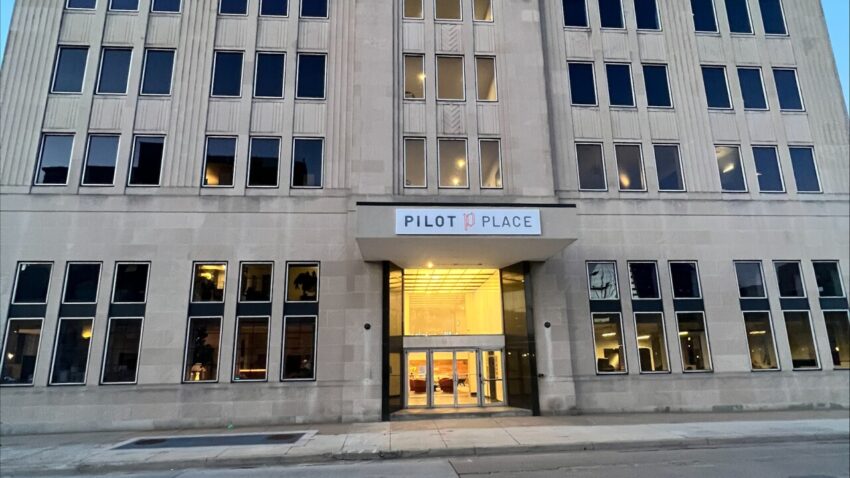
Marvin Lake’s tenure at the Virginian-Pilot in Norfolk lasted 41 years, until his retirement in 2007.
Marvin Lake, Pioneer at Virginian-Pilot, Dies at 80
Marvin L. Lake (pictured, below) the first African American reporter, editor and public editor of The Virginian-Pilot in Norfolk, Va., died Wednesday at his Norfolk home, his wife, Ruby A. Farrar-Lake, told Journal-isms. He was 80. At her request, Journal-isms is withholding the cause of death until after Tuesday’s funeral.
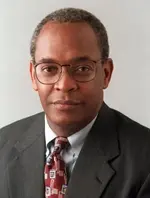 “He was The Pilot’s newsroom recruitment director for nine years and the Sunday Commentary editor simultaneously,” an obituary said.
“He was The Pilot’s newsroom recruitment director for nine years and the Sunday Commentary editor simultaneously,” an obituary said.
“Marvin directed Landmark Communications year-long Minority Training Program, The Pilot’s summer internship program and its Minority Journalism Workshop for high school students.”
Lake was also president of the Hampton Roads Black Media Professionals, named by the National Association of Black Journalists a two-time Chapter of the Year winner, and for a decade wrote a career advice column for the NABJ Journal.
Lake took a buyout in 2007 when the Virginian-Pilot, in the midst of a recession, offered them. The same year, he was inducted into the Virginia Communications Hall of Fame. In 2008, the National Association of Minority Media Executives presented him with its top honor, the Robert G. Maynard Legend Award.
“Active in the community, Marvin was project director for the City of Norfolk’s 50th Anniversary of the End of Massive Resistance Commemoration. He helped develop a book about African American history in Norfolk,” the obituary continued.
“Marvin was the president of the Crispus Attucks Cultural Center Inc., the vice president for planning and operations of the Hampton Roads Committee of 200+ Men Inc. He was a longtime chair of the organization’s annual 200+ Scholars Breakfast honoring area African-American male high school graduates with a 3.0 or better grade point average.”
A tribute from Roger W. Chesley, published internally in 2007 at the Virginian-Pilot after Lake’s retirement, is at the end of this column.
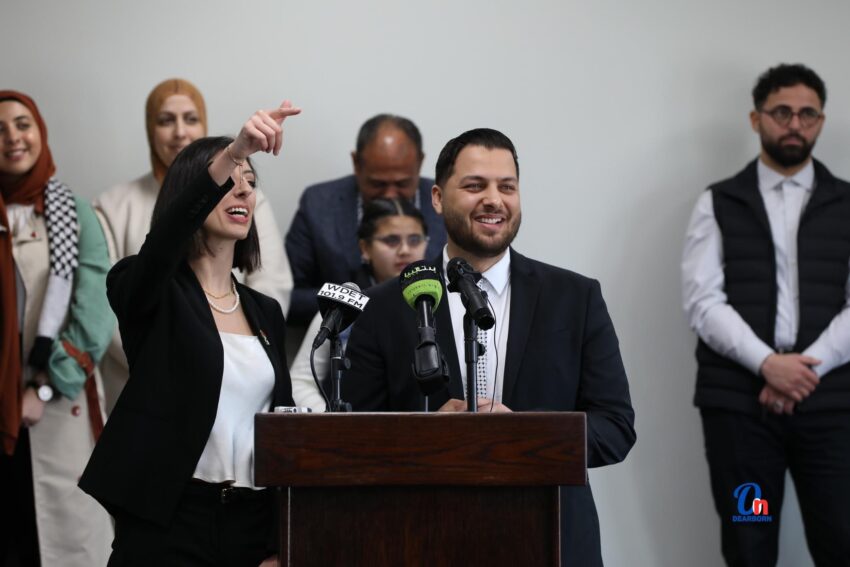
Ibrahim Samra posted this photo on X March 25, writing, “Today, I spoke my peace & I encourage other journalists to stand up against anyone who tries to silence you for who you are. When you do what’s right, you never have to worry. Allah knows.”
Detroit Palestinian TV Journalist Claims Bias, Sues
“A Metro Detroit Palestinian journalist is suing his employers, including CBS and WKBD, for discrimination after the news station fired him,” Marnie Muñoz reported March 22, updated March 23, for the Detroit News.
“Ibrahim Samra, 27, a Dearborn resident and former journalist with CBS News Detroit, filed a federal lawsuit against CBS/CTS Inc., WKBD Inc., CBS Broadcasting Inc. and Paramount Pictures Corporation last week for breach of contract, retaliation and racial, religious and national origin discrimination.
“Samra, who was the only Arab, Palestinian and Muslim employee at CBS News Detroit, alleges his employers accused him of producing ‘one-sided’ coverage after the Israel-Hamas war began in October 2023, according to a lawsuit filed with the US District Court Eastern District of Michigan.
“The loss of his reporting is really a loss for the entire community,” his attorney, Amanda Ghannam told The News.
“CBS Detroit issued a statement saying it does not comment on pending litigation or employee matters. . . .
In “October 2023, when the Israel-Hamas conflict began, Samra contends his employers began to treat him ‘differently’ than his colleagues, according to his lawsuit. He contends they used [offensive] language, rejected his story pitches and removed him from his beat covering the Metro Detroit area including Dearborn. He contends his employers also disparately scrutinized his personal social media activity, according to the lawsuit. . . .”

Shani Louk was a German-Israeli tattoo artist who was abducted by Hamas on Oct. 7.
Award for Hostage-Taking Photo Praised, Slammed
“A photograph from October 7 depicting Hamas terrorists with the half-naked corpse of German-Israeli Shani Louk has been awarded Team Picture Story of the Year, along with a collection of other graphic photos from the Israel-Hamas war, by the world’s oldest photojournalism award competition, sparking outrage online,” Eliana Jordan wrote Thursday for the Jewish Chronicle.
Photo here.
Meanwhile, “Seven journalists, including one working for the BBC, have been injured in an Israeli air strike in the courtyard of a hospital in Gaza,” the BBC reported. “Four members of the Islamic Jihad (IJ) militant group were killed in the attack, the BBC understands.”
In addition, 16 NGOs and journalist groups Friday called upon the United Nations Interim Forces in Lebanon (UNIFIL) to release the findings of its investigation into two Israeli strikes on a group of journalists in south Lebanon on Oct. 13. The strikes killed a Reuters journalist, Issam Abdallah, and injured six other media workers.
As of Saturday, preliminary investigations from the Committee to Protect Journalists “showed at least 95 journalists and media workers were among the more than 33,000 killed since the war began on October 7— with more than 32,600 Palestinian deaths in Gaza and the West Bank and 1,200 deaths in Israel.”
On the photographic honor, the Jewish Chronicle report continued, “The Pictures of the Year award, run by the Donald W. Reynolds Journalism Institute at the Missouri School of Journalism includes a Team Picture Story of the Year category which recognises ‘the collaborative effort of a photography staff covering a single topic or news story.’ First place was awarded to a selection of 20 photos from the Israel-Hamas war taken by Associated Press (AP) photographers.
“The first photo in the selection was taken by Ali Mahmoud and depicts the horrific moment in which 22-year-old Louk’s body was transported in the back of a truck by Hamas terrorists. It is captioned: ‘Palestinian militants drive back to the Gaza Strip with the body of Shani Louk, a German-Israeli dual citizen, during their cross-border attack on Israel, Saturday, Oct. 7, 2023.’
“The collection, which includes AP photos depicting both Israelis and Palestinians in the days following October 7, was posted to Instagram last week by POY and swiftly criticised by those who claimed the photographer and the agency showed disrespect to Louk and her family by snapping the distressing photo and now, winning an award for it. . . . “
However, the Chronicle reported Friday that Shani Louk’s father, Nissim Louk, has defended the award.
He told YNet: ‘It’s good that the photo won the prize’.
‘This is one of the most important photos in the last 50 years.’ “
“The organisers of the competition said: ‘The Reynolds Journalism Institute and Pictures of the Year strongly condemn the Hamas attack on October 7, and we continue to mourn the loss of innocent lives and human suffering that is occurring in the ongoing conflict. Reactions to the Team Picture Story of the Year express the greater emotions related to that conflict.
“This year and every year, the photos in the competition are selected by a panel of professional journalists tasked with identifying compelling representations of the significant news events of the year. While we understand the reactions to the pictures, we also believe that photojournalism plays an important role in bringing attention to the harsh realities of war.”
“Violence and instability in Haiti are a threat to the country’s citizens and to the journalists reporting — at personal risk — on the latest developments. VOA’s Robin Guess has the story,” the Voice of America reported Wednesday.
Did Haitian Prosecutor Order Journalist’s Killing?
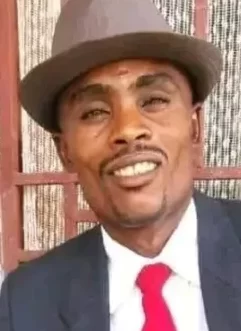 “Haitian journalist Garry Tesse (pictured) was on his way to work at a local radio station in the southern city of Les Cayes when he disappeared shortly after exiting a taxi. His naked and disfigured corpse was found six days later face down on the seashore close to downtown. One of his eyes was gouged out, his tongue was cut off, and his body was partially burned,” David C. Adams reported Tuesday for Columbia Journalism Review.
“Haitian journalist Garry Tesse (pictured) was on his way to work at a local radio station in the southern city of Les Cayes when he disappeared shortly after exiting a taxi. His naked and disfigured corpse was found six days later face down on the seashore close to downtown. One of his eyes was gouged out, his tongue was cut off, and his body was partially burned,” David C. Adams reported Tuesday for Columbia Journalism Review.
“The October 2022 murder sparked outrage and street protests. But the investigation into the death of the popular 39-year-old radio journalist has languished, leading his family and friends to accuse the government of a cover-up to protect the man who is in charge of prosecuting the crime, Ronald Richemond.
“Tesse had gone on his radio show to accuse Richemond, an influential local prosecutor and political appointee, of plotting to have him killed weeks before the murder. Now, a former member of Richemond’s security team has provided new details on the alleged plot. . . .
“Even in a country that has slid into virtual lawlessness and gang rule following the assassination of the country’s president in 2021 – a state of affairs that prompted the March 12 resignation of Prime Minister Ariel Henry – Tesse’s case has shocked local journalists and lawyers accustomed to attacks on reporters being carried out with impunity.
“The case exemplifies a long-running problem in Haiti’s justice system, experts say, pointing to a low conviction rate as investigations are snarled by political influence and crime is allowed to fester. . . .”
- Caribbean Television Network: Haiti Insecurity: Release of Journalist Lucien Jura and Continued Violence by Armed Gangs (March 22)
- Ralph Delly, Haitian Times: Haitian Filmmaker Raoul Peck to [investigate] president murder in masterpiece movie
- Brad Dress, The Hill: American guns fuel Haiti crisis
- Marc Lamont Hill, “Up Front,” Al Jazeera: Chaos Unleashed: Is Haiti Teetering on the Brink of Collapse? (video)
- Clarence Page, Chicago Tribune: Haiti’s tragic history just keeps repeating itself

Attacks on DEI Enter Coverage of Bridge Collapse
Two months after ownership of the Baltimore Sun changed hands amid handwringing over the prospect of a right-wing tilt and staff apprehension, both management and labor are praising its handling of the new owners’ first international story — the fatal collapse of the Key Bridge. But another growing thread — the attacks on diversity, equity and inclusion, known as DEI, has also entered the picture.
“Impressive wall to wall Pulitzer Prize winning coverage. Couldn’t be more proud,” messaged Armstrong Williams, a new Sun part-owner with jurisdiction over the newsroom. He said Maryland Gov. Wes Moore praised the Sun’s reporting in a conversation with him.
Responding to the same question about assessing the coverage, Christine Condon, unit chair of the Baltimore Sun Guild, said, “So many Sun Guild members jumped into action this week to deliver thoughtful and detailed coverage of a terrible tragedy, showing the value of local journalism along the way.”
But then there was the racial backlash that also demanded coverage. A headline in Rolling Out Saturday was headlined, “How the Baltimore bridge collapse became an all out attack on ‘DEI mayor.’ Other bridge collapse fatalities didn’t afford same opportunity, but mayors were white in Minneapolis and Webbers Falls, Oklahoma.”
On CNN Sunday, Moore, who is Black, responded to a question from Dana Bash about the Republicans who are trying to blame the bridge collapse “on policies that encourage workplace diversity.”
“My response is, I have no time for foolishness! I’m locked in,” Moore said, going on to list his concerns over more substantive issues.
Asked the same question last week by MSNBC’s Joy Reid, Baltimore Mayor Brandon Scott said, “We’ve been the bogeyman for them since the first day they brought us to this country, and what they mean by DEI in my opinion is duly elected incumbent. We know what they want to say, but they don’t have the courage to say the N-word, and the fact that I don’t believe in their untruthful and wrong ideology.
“And [that] I am very proud of my heritage and who I am and where I come from, scares them, because me being at my position means that their way of thinking, their way of life of being comfortable while everyone else suffers is going to be at risk, and they should be afraid because that’s my purpose in life.”
State Sen. Charles Sydnor, a Black Democrat from Baltimore County, stood on the Senate floor at the end of Thursday’s session to say, “To falsely equate diversity with a lack of knowledge and our Blackness with incompetence is simply a lie.”
Countering the increasing moves against diversity, equity and inclusion will be the subject of a Journal-isms Roundtable on April 11.
Elsewhere, journalists discussed the bridge collapse in championing the value of local news reporting and appreciation of immigrants, six of whom plunged to their deaths as they worked on the bridge.
“The Bridge Collapse in Baltimore is an Immigration Story,” reads a headline in the newsletter of APA Justice, which champions the Asian Pacific American community.
Under the headline, “Local News Radio ‘Critical’ In Crises Like Baltimore Bridge Collapse,” Radio Ink asked Craig Swagler, general manager of Baltimore’s NPR affiliate WYPR, “How do web content, social media, and beyond factor into modern radio news coverage?”
“Massively. It was a big play for us yesterday,” Swagler replied. “We had an ongoing live text blog that we put on our website. We put the latest information that we were receiving from either press conferences or sources in a live stream of information to keep people up to date in addition to the broadcasts that we were doing.
“We were also posting stories that our reporters were writing. We are in an editorial partnership with the Baltimore Banner, a nonprofit print/digital organization based here in Baltimore. Our journalism forces were combined in this story.”
And on X, Rona Kobell, who had been at the Banner two weeks, marveled at her newsroom’s report, “We spoke with one of the last drivers to cross the Key Bridge.“
Kobell tweeted, “I can’t stop thinking about this story, and how Baltimore it is. The way coworkers know each other’s commutes. The way people see friends of 50 years on a daily basis. And that that the last man who crossed is @KaitlinObscura’s mother’s cousin-in-law.” @kaitlinObscura is her colleague Kaitlin Newman, managing photo editor and staff photojournalist at the Banner.
- Lorraine Ali, Los Angeles Times: The Baltimore bridge collapse reminds us immigrants often do unheralded and dangerous work
- Aria Brent and Tashi McQueen, AFRO: Community members rally in wake of Key Bridge collapse, CASA highlights immigrant victims
- Cary Clack, San Antonio Express-News: With SB 4, the darker the skin, the greater the suspicion (March 22)
- Petula Dvorak, Washington Post: The men who fell from that bridge are the people who build our nation
- Emmanuel Felton, Washington Post: Baltimore mayor weathers racist attacks after bridge collapse
- Jacob Fenston, NPR: Baltimore bridge collapse has put the spotlight on Maryland’s young Black governor
- Suzette Hackney, USA Today:In Baltimore, the city’s youngest mayor faces triumph, tragedy in a single week
- Cassidy Jensen, Baltimore Sun: At Easter Mass, East Baltimore’s Latino community mourns Key Bridge workers
- Roy S. Johnson: Alabama Republicans proudly drag us back to the 1950s, or beyond
- Adam Mahoney, Capital B: The Port of Baltimore Tore This [Black] Community Apart Long Before the Key Bridge Collapse
- Torod B. Neptune, LinkedIn: Can we take back the inclusion, diversity, and equity story?
- Tracie Powell, Pivot Fund: Meet the Baltimore Sun’s other new owner, Black entrepreneur Armstrong Williams (March 21)
- Terrance Sullivan, Courier Journal, Louisville, Ky.: Kentucky lawmakers, say it with your chest. Admit that you’re racist.
- N’Dia Webb, Howard University News Service: Baltimore’s Francis Scott Key Bridge collapses after ship collision
Short Takes
- “Two journalists who were cornered and attacked by the Minnesota State Patrol as they covered protests over George Floyd’s murder for the Los Angeles Times will soon settle a lawsuit with the state for $1.2 million,” Hannah Wiley reported Wednesday for the Times. “The pair, one current and one former L.A. Times employee, alleged the troopers violated their 1st Amendment rights. The settlement stems from a violent May 30, 2020, incident, when staff photographer Carolyn Cole and Molly Hennessy-Fiske, then The Times’ Houston bureau chief, were in Minneapolis covering the community’s response to Floyd’s murder by former Police Officer Derek Chauvin. . . .”
- “A Los Angeles Times column criticized as ‘sexist’ by LSU women’s basketball coach Kim Mulkey was changed online by the newspaper early this morning because it ‘did not meet Times editorial standards,’ ” Bruce Haring reported Sunday for Deadline. “LSU beat UCLA 78-69 on Saturday to advance in the Women’s NCAA tournament. Before the game, columnist Ben Bolch wrote that the Lady Tigers were ‘dirty debutantes’ and called them ‘villains,’ while calling the Bruins ‘milk and cookies.’ He called the matchup ‘good versus evil.’ . . .” LSU guard Hailey Van Lith, who is white, said, “We do have a lot of Black women on this team, and unfortunately, that bias does exist still today, and a lot of the people that are making those comments are being racist towards my teammates,” Andrea Adelson reported Sunday for ESPN.
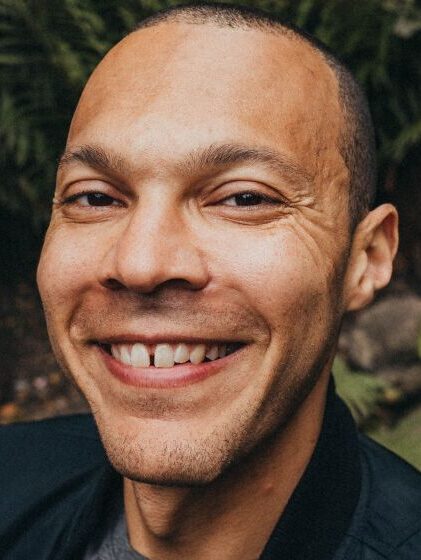 “Andrew Simon (pictured), an experienced nonprofit media leader and magazine editor whose work has focused on serving highly engaged, informed audiences, will be the new editor-in-chief of the Chronicle of Philanthropy, an independent journalism organization that helps nonprofits, foundations, and others better understand trends and advance meaningful social change,” the Chronicle announced Tuesday.
“Andrew Simon (pictured), an experienced nonprofit media leader and magazine editor whose work has focused on serving highly engaged, informed audiences, will be the new editor-in-chief of the Chronicle of Philanthropy, an independent journalism organization that helps nonprofits, foundations, and others better understand trends and advance meaningful social change,” the Chronicle announced Tuesday.
- “Media attention can boost a scientist’s career, bringing them prestige and making it easier to attract collaborators and students. But there are disparities in who gets named in news stories about scientific research, according to a new study: Scientists with East Asian and African names are less likely to be mentioned or quoted in stories that reference their work,” Katie Langin reported Tuesday for Science.
- “The U.S. Office of Management and Budget announced Thursday it would combine questions about race and ethnicity on federal forms and encourage people to select multiple options if applicable,” Patrick Svitek reported for The Washington Post. “The government also will add ‘Middle Eastern or North African’ (MENA) as a new category for the combined question, which will include seven total choices. . . . Advocates have especially pushed for a combined question on race and ethnicity, with research showing that the separate questions have hindered data collection among Latino respondents. . . .”
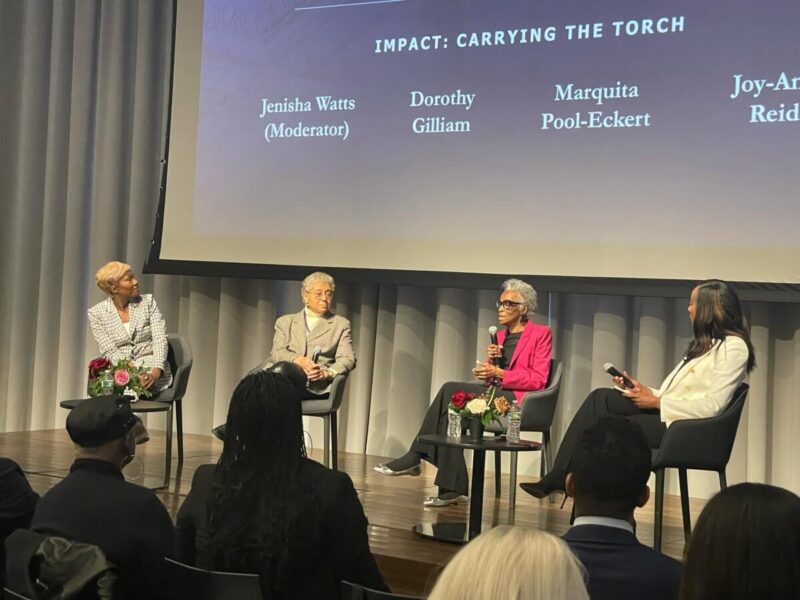
From left, Joy Reid, Marquita Pool-Eckert, Dorothy Gilliam and Jenisha Watts. (Credit: Melanie Eversley)
- “Distinguished national voices in media, scholarship and the arts joined the Columbia Journalism School in commemorating the life, legacy, and journey of Ida B. Wells, last Monday, March 25 – the 93th anniversary of the activist journalist’s passing,” Brooklyn, N.Y.-based Our Time Press reported. “It was a day of insightful and revelatory conversations, culminating in the unveiling of a bronze statue of Wells by West Coast artist Dana King, a former broadcast news anchor. The bust, a gift of Mark Mason and Carolyn Mason, is located in the lobby of Pulitzer Hall. The panelists included: Dean [Jelani] Cobb; Kimberlé Crenshaw; June Cross, Fred W. Friendly Professor of Media and Society; Dan Duster [Wells’ great-grandson]; Paula Giddings [a Wells biographer]; Dorothy Butler Gilliam, ‘61 M.S.; Errin Haines; Nikole Hannah-Jones; Dana King; Marquita Pool-Eckert, ‘69 M.S.; Joy-Ann Reid; and Jacqueline Woodson. . . . “
- After an artificial-intelligence-generated video showed Arizona Republican Kari Lake speaking words written by a software engineer — a maneuver known as a “deep fake,” Missouri activist Don Calloway, Democratic strategist and founder of the National Voter Protection Action Fund, suggested that the National Association of Black Journalists and other journalism organizations develop a position on the use of artificial intelligence in news stories. After all, Calloway said March 24 on Al Sharpton’s “PoliticsNation” show on MSNBC, Sharpton is “a longstanding member in good standing” of NABJ. An NABJ spokesperson said it was unable to confirm whether Sharpton is in fact, a member. [Update: NABJ said April 12, “Rev. Sharpton is not an annual NABJ member. He has, however, been a past NABJ Convention participant.”]
- Dow Jones and Columbia Journalism School announced the expansion of the annual Historically Black Colleges and Universities (HBCU) Media Collective. “From May 29 to June 12, 2024,” the eight participants of this journalism training program “will work alongside professional journalists at Dow Jones’s Barron’s and MarketWatch newsrooms, and participate in newsroom training hosted by The Wall Street Journal. Fellows will also take graduate-level courses at Columbia University during the first part of the program. . . . As part of this year’s extended program, fellows will have the opportunity to travel to London for five days, gaining valuable exposure to News Corp properties including The Sun, The Times, Times Radio, The Fifth, talkSPORT and Virgin Radio, . . .” the school said on March 19.
- When Black historian Rayford W. Logan researched the “Lost Cause” Myth in at least 12 major Northern papers, “he discovered that Northern writers overwhelmingly approved of many racially-exclusive, North-South alliances: Republican President Rutherford B. Hayes’s withdrawal of federal troops from the South; white supremacist protests, riots, and blockades against African American migration from the South to the North . . . Northern media outlets rarely published Black authors and those who fit the ‘acceptable’ Black narrative according to the standards of white supremacy, such as Booker T. Washington, were usually celebrated. White authors who were published in these texts rarely challenged or offered any counter-arguments regarding the depiction or treatment of African Americans in the press,” Marvin Walker wrote Tuesday for the African American Intellectual History Society.
- . . . In ” Lost Cause” mythology, constructed after the Civil War, “the cause of the war was framed as ‘Northern aggression’ rather than slavery,:” Charles M. Blow wrote March 20 for The New York Times. “A lore about happy slaves and benevolent enslavers proliferated. The narrative valorized those who seceded from and fought against the United States.. . . And it has survived to some degree for over 150 years, tucked into the cracks of our body politic. It still surfaces in ways that may seem remote from the Confederate Lost Cause myth, but that definitely promote it.” Blow cited Florida’s efforts to change African American history standards, Nikki Haley’s hesitance to say that slavery was the cause of the Civil War and Donald Trump, who “has his own version of the Lost Cause, one that’s not completely untethered from the old one, but one that’s miniaturized, personal and petty. . . .”
When Joy Sewing was named news columnist in December, the Houston Chronicle said, “She’ll report and opine on issues including social justice, politics, education, health care and inequity (Video credit: KREK)
- “As we celebrate Women’s History Month, Melanie Lawson is shining a spotlight on an award-winning journalist. Joy Sewing was recently promoted to News Columnist at the Houston Chronicle,” KTRK in Houston reported Friday. “She is the first black woman to hold that post. Before news, Joy covered fashion for more than 15 years, but she shares with Melanie why her perspective in life changed and why she was inspired to tell stories in a bigger way.”
 “In a month that Gannett announced it is dropping its expensive Associated Press service, it has also parted company with three high-level news executives,” Rick Edmonds reported Wednesday for the Poynter Institute. Among them is “Senior director of news learning Cynthia Benjamin (pictured), who has spent her entire 36-year career at Gannett papers and corporate jobs . . . In a LinkedIn post, she said that she was contemplating retiring later this year but was told her last day would be April 1.” Benjamin wrote, “I impacted newsrooms by crafting a vision for valuing and including Black and Brown voices, supported and developed careers, co-created learning academies, advisory groups and mobile newsrooms, inspired journalists and freelance writers to reach higher, achieve more, overcome challenges, and hang on in there. Yes, I have a happy day to see people prospering in these ways. . . .”
“In a month that Gannett announced it is dropping its expensive Associated Press service, it has also parted company with three high-level news executives,” Rick Edmonds reported Wednesday for the Poynter Institute. Among them is “Senior director of news learning Cynthia Benjamin (pictured), who has spent her entire 36-year career at Gannett papers and corporate jobs . . . In a LinkedIn post, she said that she was contemplating retiring later this year but was told her last day would be April 1.” Benjamin wrote, “I impacted newsrooms by crafting a vision for valuing and including Black and Brown voices, supported and developed careers, co-created learning academies, advisory groups and mobile newsrooms, inspired journalists and freelance writers to reach higher, achieve more, overcome challenges, and hang on in there. Yes, I have a happy day to see people prospering in these ways. . . .”
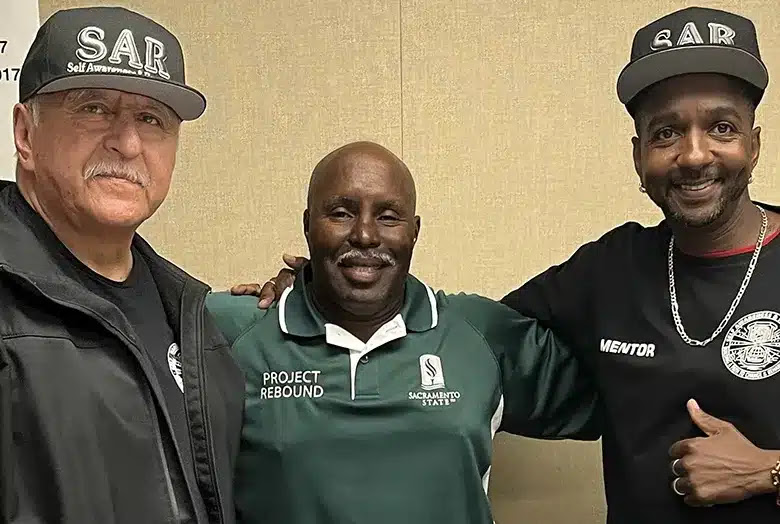
Former prisoners Daniel Silva, left, Alvin Kimbrough and Jerome Anderson (Credit: Human Media)
- An audio documentary from Human Media, “Helping Prisoners to Heal,” spotlights “three former prisoners — some who’ve spent years in solitary confinement. They’ve all now been released, in one case when a sentence of life without the possibility of parole was revised in part due to ‘exceptional conduct’. They have experienced profound transformation through Houses of Healing and a related project called Self-Awareness and Recovery. Their stories are deeply moving and offer a tribute to resilience of the human spirit.”
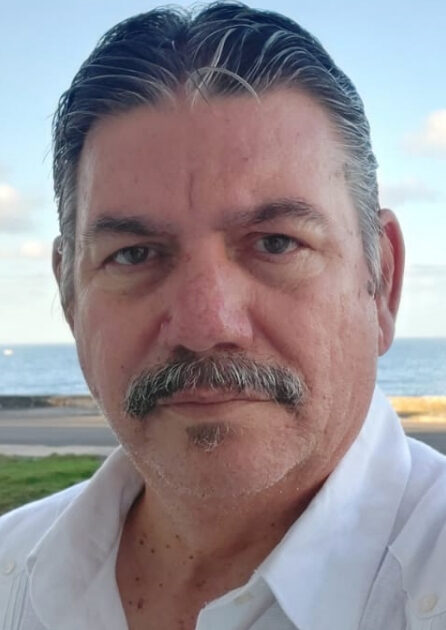 In Cuba, “A short video shows the moment when a man entered, last Monday, the building where independent journalist Julio Aleaga Pesant (pictured) resides on 1st Street, between C and D, in El Vedado, Havana,” 14YMedio reported Wednesday. “About 40 minutes later, the same security camera, from a private cafeteria located on the ground floor of the building, captures the subject leaving with a bicycle and a bulging bag. . . .” “It looks like they went straight to the laptop,” the uniformed men told Aleaga. He “suspects that State Security is behind the robbery, since they have harassed the journalist for years, with police operations around his home, subpoenas and arrests. . . .”
In Cuba, “A short video shows the moment when a man entered, last Monday, the building where independent journalist Julio Aleaga Pesant (pictured) resides on 1st Street, between C and D, in El Vedado, Havana,” 14YMedio reported Wednesday. “About 40 minutes later, the same security camera, from a private cafeteria located on the ground floor of the building, captures the subject leaving with a bicycle and a bulging bag. . . .” “It looks like they went straight to the laptop,” the uniformed men told Aleaga. He “suspects that State Security is behind the robbery, since they have harassed the journalist for years, with police operations around his home, subpoenas and arrests. . . .”
- In Britain, “The Metropolitan Police has settled with three journalists detained and stopped from covering a Black Lives Matter protest in London in 2014,” Charlotte Tobitt reported Wednesday, updated Thursday, for Press Gazette. “Video journalist Jason N Parkinson, photographer Jess Hurd and another unnamed photojournalist, all members of the National Union of Journalists, have accepted an apology and out-of-court settlement from the police force. “But they criticised the fact key evidence was seemingly lost meaning the case took more than nine years to settle and noted that UK police have issued many such apologies after hindering the work of journalists. . . .”
- “A majority of the world’s population has experienced a decline in press freedom in recent years, according to a UN report. In east Africa, the results are mixed and debatable,” Karen McIntyre and Meghan Sobel Cohen wrote March 18 for The Conversation Africa. “In Rwanda, both international press freedom rankings and journalists on the ground say press freedom has increased over the past 10 years. In neighbouring Uganda, both international rankings and local journalists say media freedom has declined. In Kenya, rankings reflect declining freedom over the past decade, but reporters acknowledge they have more freedom than their counterparts in Uganda and Rwanda. . . .”
From the company ‘Intranet’ at the Virginian-Pilot in Norfolk, Dec. 20, 2007 . . .
Marvin Lake, first black summer intern at The Pilot, caps a 40-year career in journalism
By Roger Chesley, Pilot Editorial
If he hadn’t been so persistent, Marvin Lake (pictured below, with the caption, “Marvin Lake eager and ready to go”) wouldn’t have been hired at The Virginian-Pilot more than 40 years ago. Both the newspaper and Hampton Roads should thank his resolve.
 In a career that would go on to include numerous reporting beats, city editor slots, and stints as recruitment director and finally, public editor, Marvin first had to convince the institution to bring him on board. Before Marvin, there had been no black summer interns, no black reporter s.
In a career that would go on to include numerous reporting beats, city editor slots, and stints as recruitment director and finally, public editor, Marvin first had to convince the institution to bring him on board. Before Marvin, there had been no black summer interns, no black reporter s.
And persuading people to make you “the first” is never easy.
Here’s the story: It was 1966, during a time of social upheaval and civil unrest in America. Marvin was a junior at Norfolk State University, and the budding writer learned that The Pilot had one summer internship available — at least, that’s what newspaper officials told him by phone. If he could get in quickly for an interview, he might snag the slot. A day or two later, Marvin showed up at the human resources department. Suddenly, the position was “filled.”
He didn’t make a scene, but Marvin wouldn’t leave until officials looked at his strong package of clips, including his weekly columns for The Journal and Guide and a story from The Pilot noting he was the editor of NSU’s student newspaper.
A couple of months later, he was a Pilot intern.
“Somebody appreciated the possibilities,” Marvin, 63, told me recently. His tenure here would stretch 41 years, until his retirement in December.
To newcomers on the editorial side, he’s that persnickety guy who’s an accuracy scold, fixing the slightest of errors that have appeared in print. He even wrote a correction when someone left out an exclamation point in the TV game show “Jeopardy!”
That caricature, however, doesn’t do him justice. Colleagues and folks he’s mentored over the years say he was a dogged reporter who, through vivid details and painstaking craftsmanship, placed readers in the middle of the story.
Reporter Bill Burke has known Marvin since the early 1970s, and says he was a thorough reporter who was “intellectually fair.” Marvin could capture the essence of his subjects, Burke said. He cited a profile of Rosa Mae Alexander, a matriarch in the black community.
“Marvin knew Norfolk. Marvin knew politics,” said Derek T. Dingle, 46, a former copy aide and intern at the paper who today is vice president/executive editor of Black Enterprise magazine. “He was one of the best-read persons I knew. … He always made you want to gain more knowledge in general.”
Dingle counts Marvin as a key mentor, but also one who could be a tough task master. Dingle often would show his raw copy to Marvin, seeking advice. “Many times I’d regret it, because it would come back bleeding in red ink,” Dingle recalled, chuckling. “Marvin was a precise editor for words, language … especially using 10-dollar words when you could use 5-cent words.” But those exercises “led me to becoming a better writer.”
His guidance propelled many careers around the country. Michelle Mizal-Archer, 31, is a former Pilot reporter now working as a TV reporter in Hawthorne, Calif. She credits Marvin with helping her get a job at The Pilot while she was still a teen, and counseling her throughout her years in the business. “He’s always been a mentor to me,” she said by phone from California. “I just called him a few months ago to talk. … He’s always a listening ear.”
Just as important to Marvin, though, was bringing broader perspectives to The Pilot, both inside the newsroom and within its pages. He wanted the paper to be more sensitive to the minority communities it covered, and he sought the hiring of more blacks and other minorities on staff.
For example, he said in his farewell column, he successfully advocated “that it was discriminatory to report the race of blacks charged with crimes but not that of whites.”
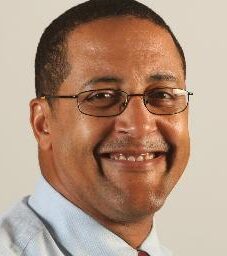 “There was a big distrust among blacks of The Virginian-Pilot,” he told me (pictured).
“There was a big distrust among blacks of The Virginian-Pilot,” he told me (pictured).
Over the decades, he did what he could to improve the relationship. Among his greatest accomplishments at the paper, he says, was conceiving, narrating and hosting the television documentary, “Church Street: Harlem of the South,” and helping to conceive and edit a three-day newspaper series, “Church Street: What Was Lost.” At various times, he directed the paper’s Summer Minority Journalism Workshop for high school students and ran the Landmark Minority Internship, a year-long program that brought minorities into newsroom jobs with the company’s newspapers.
Away from work, Marvin’s passions ranged from books to music, from working with community organizations to teaching at Norfolk State and Hampton universities. He formerly produced a weekly jazz radio program for WOWI-FM. He was the longtime co-chair of the Virginia Press Association’s Diversity Committee.
In April 2007, he was inducted into the Virginia Communications Hall of Fame. That’s part of his stash of numerous journalism awards and citations.
Retirement affords him more time to spend with his wife, Ruby, read more books, free-lance and maybe even take up an exercise program at the gym. “If they have a steam room, that would be nice.”
One thing’s for sure: Like the young man who wouldn’t take no for an answer 41 years ago, if Marvin sets his mind to it, he’ll succeed.
To subscribe at no cost, please send an email to journal-isms+subscribe@groups.io and say who you are.
Facebook users: “Like” “Richard Prince’s Journal-isms” on Facebook.
Follow Richard Prince on Twitter @princeeditor
Richard Prince’s Journal-isms originates from Washington. It began in print before most of us knew what the internet was, and it would like to be referred to as a “column.” Any views expressed in the column are those of the person or organization quoted and not those of any other entity. Send tips, comments and concerns to Richard Prince at journal-isms+owner@
View previous columns (after Feb. 13, 2016).
View previous columns (before Feb. 13, 2016)
- Diversity’s Greatest Hits, 2018 (Jan. 4, 2019)
- Book Notes: Is Taking a Knee Really All That? (Dec. 20, 2018)
- Book Notes: Challenging ’45’ and Proudly Telling the Story (Dec. 18, 2018)
- Book Notes: Get Down With the Legends! (Dec. 11, 2018)
- Journalist Richard Prince w/Joe Madison (Sirius XM, April 18, 2018) (podcast)
- Richard Prince (journalist) (Wikipedia entry)
- February 2018 Podcast: Richard “Dick” Prince on the need for newsroom diversity (Gabriel Greschler, Student Press Law Center, Feb. 26, 2018)
- Diversity’s Greatest Hits, 2017 — Where Will They Take Us in the Year Ahead?
- Book Notes: Best Sellers, Uncovered Treasures, Overlooked History (Dec. 19, 2017)
- An advocate for diversity in the media is still pressing for representation, (Courtland Milloy, Washington Post, Nov. 28, 2017)
- Morgan Global Journalism Review: Journal-isms Journeys On (Aug. 31, 2017)
- Diversity’s Greatest Hits, 2016
- Book Notes: 16 Writers Dish About ‘Chelle,’ the First Lady
- Book Notes: From Coretta to Barack, and in Search of the Godfather
- Journal-isms’ Richard Prince Wants Your Ideas (FishbowlDC, Feb. 26, 2016)
- “JOURNAL-ISMS” IS LATEST TO BEAR BRUNT OF INDUSTRY’S ECONOMIC WOES (Feb. 19, 2016)
- Richard Prince with Charlayne Hunter-Gault, “PBS NewsHour,” “What stagnant diversity means for America’s newsrooms” (Dec. 15, 2015)
- Book Notes: Journalists Follow Their Passions
- Book Notes: Journalists Who Rocked Their World
- Book Notes: Hands Up! Read This!
- Book Notes: New Cosby Bio Looks Like a Best-Seller
- Journo-diversity advocate turns attention to Ezra Klein project (Erik Wemple, Washington Post, March 5, 2014)

